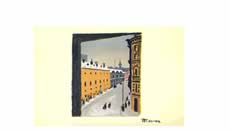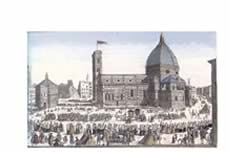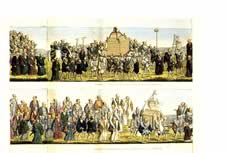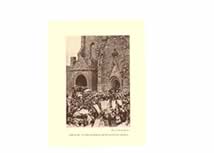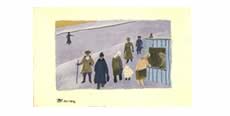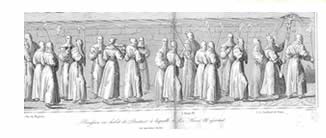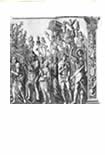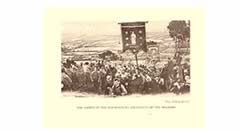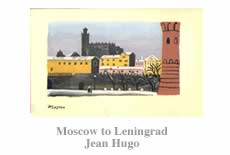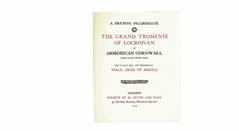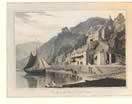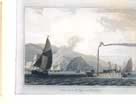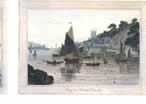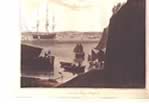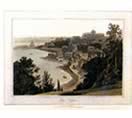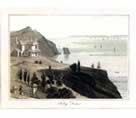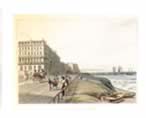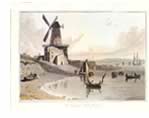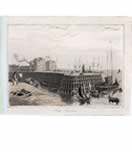Voyage a Moscou et Leningrad A concertina book conceived,
planned and executed by Jean Hugo.Published by Editions Cercle d'Art. Paris
1953. Each page has an illustration and measures 14 x 17cms. The
journey begins with the flight from Orly airport to Moscow and the train
journey to Leningrad. Hugo returns to Moscow and then flies back to Paris.
Although giving the appearance of a production of a private press, the book
is volume produced in offset litho by Imprimerie Moderne de Lion in Paris
in 1953. There is a real feeling of travel - scenes of towns interspersed
in paintings of the sky and airports.
 THE BOOK COMPLETE THE BOOK COMPLETE
|
Going on a Pilgrimage :the prescribed route A pilgrim
is one who journeys to some sacred place as an act of devotion, and normally
by a determined route. There are specified places for worship, usually
in the presence of some relic. See Marie Madeleine Gauthier, Highways
of the Faith , Alpine Fine Arts, London 1987. There are many
published accounts of the rituals enacted and the privations endured on
a pilgrimage. Here is a favourite - a pilgrimage in Brittany in 1911.
The religious ceremonies of the Breton people were of abiding interest
to scholars and artists. Gauguin and Wyndham Lewis looked on with a sense
of awe. In Lewis' case his interest was tempered by a fascination with
their quaint and intuitive ways which he mocked/analysed in a set of short
stories as early as 1909.
"Just as England has her Cornwall, so has Brittany her Cornouille,
viz. Amorican Cornwall.... " Every sixth year a 'pardon' was held
in honour of the sixth century saint S.Ronan. The Grande Tromenie is held
on the second Sunday of July, and is a mass procession that follows the
route taken by two oxen who, on the saint's death, were allowed to wander
of their own accord from his place of death to a place of burial ( the
hill outside the village of Locranon). After a service in the church nearly
15,000 worshippers climb the hill with their relics, past crosses and
other memorials. The author complained that he could only find refreshment
at the summit in drinking syrups, each stickier than the last. How different,
he complains, from the Godless hordes of England's Epsom and Derby Day.
|
The Procession M.Titsingh, Illustrations of Japan... , Ackerman,
London, 1822. A panoramic spread illustrating a Japanese funeral procession.
One of the earliest books to record Japanese design and the trappings
of everyday life. The author was Chief of Settlement for the Dutch East
India Company in Nagasaki. A penitential procession at the funeral of
the French King, Henry III,from a collection of instructional engravings
for children, c183012 x 38cms.
A print
called a Vue D'Optique of Florence Cathdral and a stately religious procession.
c1760.and to be viewed through a stereoscope. The design and implementation
of processions is a fascinating matter, involving
sequence,
etiquette
figure and ground
characterisation and
the ability to orchestrate a multi-figure composition.
Look at the Mantegna Triumphs , the section in this database on Petrarch's
Triumphs, and the choreography of the Festival Floats during two revolutions,
the French and the Russian.
Bartoli's engraving after Mantegna's Triumph of Caesar.
|
|
Through the
Landscape
These are images from Thomas and William Daniell's A Voyage Round Great
Britain, undertaken in the summer of the year 1813 , "and commencing
from the Land's End, Cornwall", 8 volumes, 1814 - 1825 and being
308 hand coloured aquatints. The prints gives a unique visual account
of the appearence of the coastline - assembled in geographical sequence.
Torbay,
Devon
Clovelly
on the Coast of North Devon.
Fowey,
Cornwall
The Townsend Mill, Liverpool
Seacombe
Ferry, Liverpool.
The Clyde Near Dumbarton
Hull, Yorkshire
Brighton Sea Front
Rye in Sussex
William Daniell had accompanied his uncle Thomas to India in 1784, an
experience to find publication in the Oriental Annuals starting in 1808.
In 1814 they set out to assemble coastal views of Great Britain begining
on the northern coast of Cornwall and travelling through Wales and Anglesey,
up the north west coast of the UK to Scotland. They were accompanied by
Richard Ayton, a topographical writer of great talent and style, who died
after seeing his first descriptions in print. The text to the eight volumes
of prints was taken over by William himself.
Over the period of publication, the Daniells would travel during the summer
and prepare the prints over the winter in colours of brown and grey .
The prints were then handcoloured by the firm of William Timms of Hampstead
Road, London.
Ronald Russell, Guide to British Topographical Prints
, David and Charles, Newton Abbot 1979.
Geoffrey Grigson, Britain Observed , Phaidon Oxford 1975.
Michael Clarke, The Tempting Prospect; A Social History of English
Watercolours, Collonade, London 1981.
|




